SIGHT CASTING GOLD BARS WITH BAIT....
Archie Coote provides all you need to know about targeting yellowfin whiting the good old fashioned way!
Over the last decade yellowfin whiting fishing has become not only more popular, but also more complicated. With the combination of those two factors many day-to-day anglers have seen a decline in their summer yellowfin whiting hauls. Since discovering the run of yellowfin whiting half a dozen years ago, I have struggled to catch more than three fish in a three-hour session, using the cream of the crop when it comes to small top-water lures. On so many occasions I could see the fish just metres away from the rod tip, but they would not look up at my stick bait or popper. Last summer I had had enough. It was time to go back to the old hook, line, and sinker. I ended up leaving the sinker out, however. The summer became my most prolific for yellowfin along the Eyre Peninsula coastline, highlighted by two big hauls of nine and 11 fish, between 35-42cm. Here is the process I learned and used from morning to afternoon to improve my chances of catching a feed.
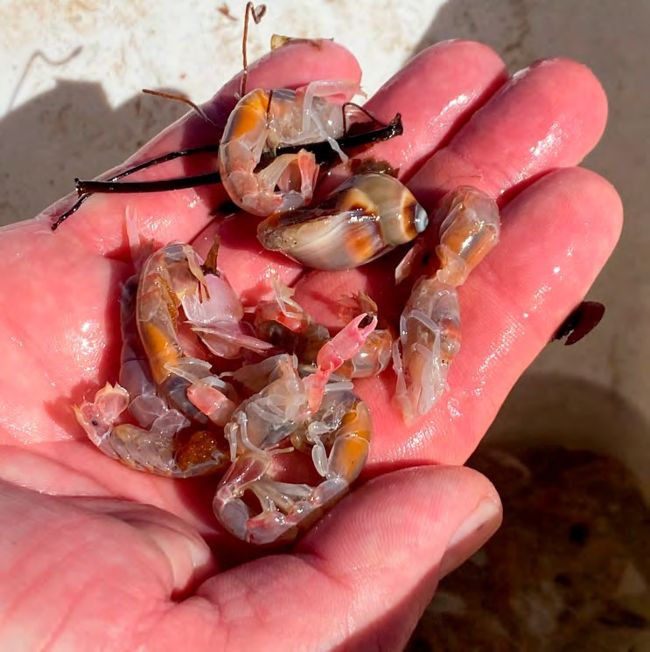
Clickers make great bait for yellowfin
COLLECTING BAIT
When the tide is at its lowest in summer, many anglers, especially land-based specialists, are cooking bacon and eggs, waiting for the high afternoon tide to have a crack. But the beauty of a low morning tide is the opportunity to discover structure and collect bait on the coastline, on sand flats especially. On these sand flats you may find small mounds of sand with a depression next to them.
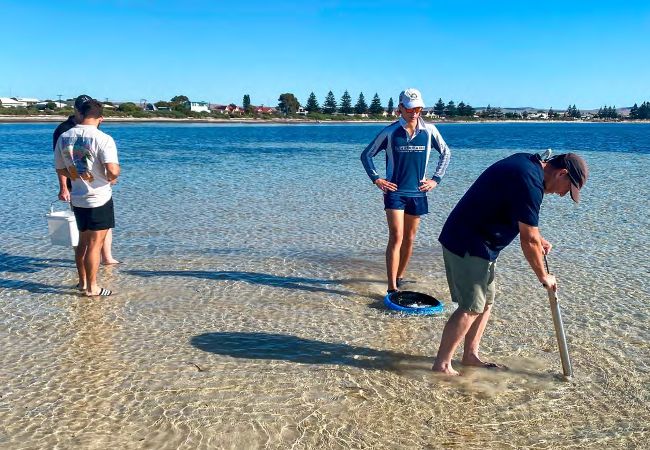
A decent bait pump is essential for bait collecting
These can be in their hundreds. This is a sign of clickers, also known as bass yabbies, or nippers. These are pieces of chocolate for yellowfin whiting.
With a bait pump in hand it becomes possible to suck the clickers out from their holes, by simply placing the end of the bait pump on the peak of the mound, which should have a tiny hole were the clicker enters and exits. After sucking up the sand, and hopefully a clicker or two, pumping onto a large sieve or water tank filter can reveal the target species. To make this process a bit more fun, and especially enjoyable for young anglers, pump into the shallow water, and let those watching spot the clickers in the water. Some do have small claws that can give a pinch, but clickers are relatively docile, so if you are quick enough, there will not be any little screams. Clickers are usually pink with an orange underbelly, but can be transparent and generally vary in lighter colours. The orange underbelly is what is easiest to look out for. The key is to keep these clickers alive until the afternoon when the tide is high, and it is time to throw them on the hook. An inch of sand at the bottom of a spacious salt water-filled bucket should achieve this, if they are kept in shade. Some other species that you may stumble upon while bait pumping are both blood and sand worms, shrimp, and the odd scallop on surface if the water is deep enough. Yellowfin will still take these on occasions, but they are a last resort for us. Please wear some form of footwear while going over the flats, as razorfish may be apparent.
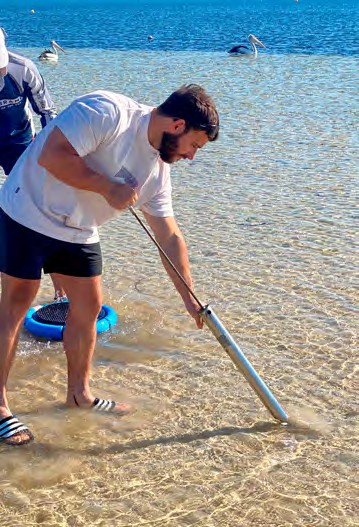
TACKLE AND RIGGING
Repurposing a squid or boat whiting rod will make life difficult while casting fragile and light clickers, especially since the rig used has no additional weight. The rig used for this method is as simple as it gets… a hook on the end of a line. To be more specific, a rod’s length of 6-10lb fluorocarbon leader, backed by the same weight of smooth braid. On the end of the leader tie a size 8 or 10 baitholder hook, to give the best chance for the clicker to survive the cast. It is not uncommon to try to cast a little too far or a little too hard, and the clicker goes flying.
The reason for the light rig is not to spook the yellowfin as the bait hits the calm surface. Using such light equipment to this point requires an adaptable and flicky rod. A 7-foot 4 inch rod with the line class of 1-4kg will match these requirements. Pair this with a 1000 sized reel. Often there is a lack of structure that yellowfin can wrap your line around, meaning you can listen to the light drag scream, and not have to worry. Even if you do lose the fish, it’s just one hook.
Some other handy things to take along for the fishing trip are a bait bucket for your clickers, to tie around your waist, and catch bag. Finally, setting the hook into the clicker should focus on stability, and its presentation, over how exposed the hook is. The soft bait will allow for the hook to set nicely. In the end it is quite simple. Make the first incision into the top side of the tail before turning the hook to face the belly of the clicker, and finally pin it through there. This should all fit before reaching the eye of the hook.
IDEAL WEATHER
For sight casting it is paramount the water has excellent visibility, and that waves are not causing too much ripple. This, along with the wind, of course. An onshore breeze will most likely have already caused murky water, and will also make casting a nightmare. A directly offshore breeze can have the same effect. Overall, it comes down how you are going to wade over the sand banks. Looking to cast with the wind behind your back, with a southerly breeze along an east-facing coast, you would look to track north, therefore having the wind behind you, allowing for an easier cast. It is important there be enough water for the yellowfin to feed in. The lowest I have encountered them is knee deep, but ideally in between the knees and waist will give the best chance of high numbers being in the area. The height of the tide for this standard varies for every location, so I cannot give a specific number.
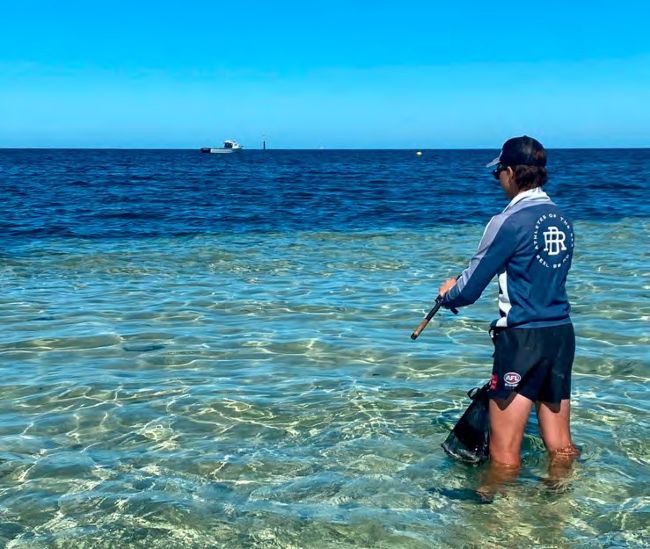
Prospecting the weed margins of sand flats can be productive
SCOUTING AND LANDING
Firstly, you must select the location in which you are going to fish. On most occasions this will be the area that you collected your bait earlier in the day, as the yellowfin have since arrived with the tide, knowing there is food there. In the morning it is important to note where the water is shallower and where the gutters and/or channels are. Both can be places in which yellowfin will hunt. The first instinct is to fish off these sand bars, where it is shallower, but you may be scaring more yellowfin away than you are seeing. It is not rare for me to stand in the deeper gutters and cast onto the sand bars, but it is not as easy as standing and casting.

Keeping on the move is impor tant, as yellow fin are also hunting on a timer, before the tide begins to recede. It is best to plan ahead, looking for a stretch of water to wade along at a slow, and quiet pace. A simple obser vation from the beach before going out is all it is. You may spot three yellow fin within 5m, but then miss the hook set. It does not mean the other two are still going to be sitting there. They keep moving, so you need to keep moving along as well.
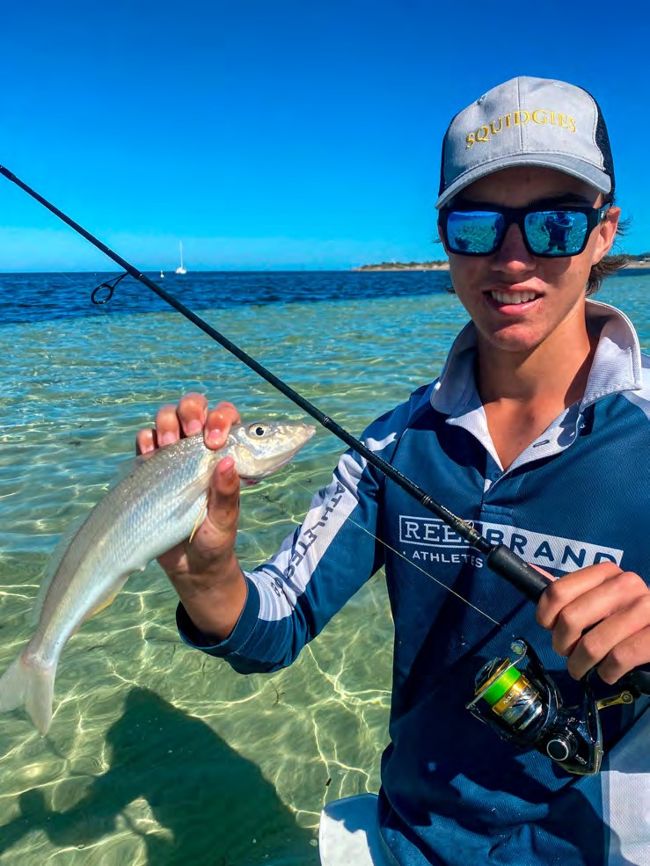
A 1000-2000 size threadline reel is ideal
Spotting yellow fin is a skill that needs practice. These fish are designed to camouflage into sand, making them sometimes indistinguishable. Looking for their shadow is the best bet, along with the occasion light reflected from their scales. The most frustrating thing, however, is thinking you saw a shadow, casting at it, and realising the shadow is coming from seaweed floating on the sur face. When you assuredly do sight a yellow fin, make sure to maintain eye contact, and not lose the fish’s whereabouts. This means already having a clicker on the hook, and the bail-arm undone. It should be a flick of the wrist and letting go of the line. Cast ahead of where the yellow fin is moving, as it should hopefully spot the clicker as it sinks from the sur face. If the clicker makes it to the sand bed, and the yellow fin seems unfazed, give the rod a slight jiggle, with some tension, moving the clicker in a natural way. As the yellow fin strikes, which usually gives an appealing visual display, keep the spool open, and let the fish run for three to five seconds. They usually hold the bait in their mouths for this time before making a commitment to swallowing. This amount of time should ensure that the fish is releasable if needed or if you are doing a catch and release session.
Yellowfin whiting are some of the most enjoyable fish to fight and are some of the toughest pound-for-pound in our waters, made more enjoyable by the light outfits used. These fish taste great from the fish markets, but even better af ter getting up in the morning to start pumping bait. Hopefully, you have found another way to enjoy the warmer months, and another way to impress the friends and family with a bag of fresh yellow fin whiting.